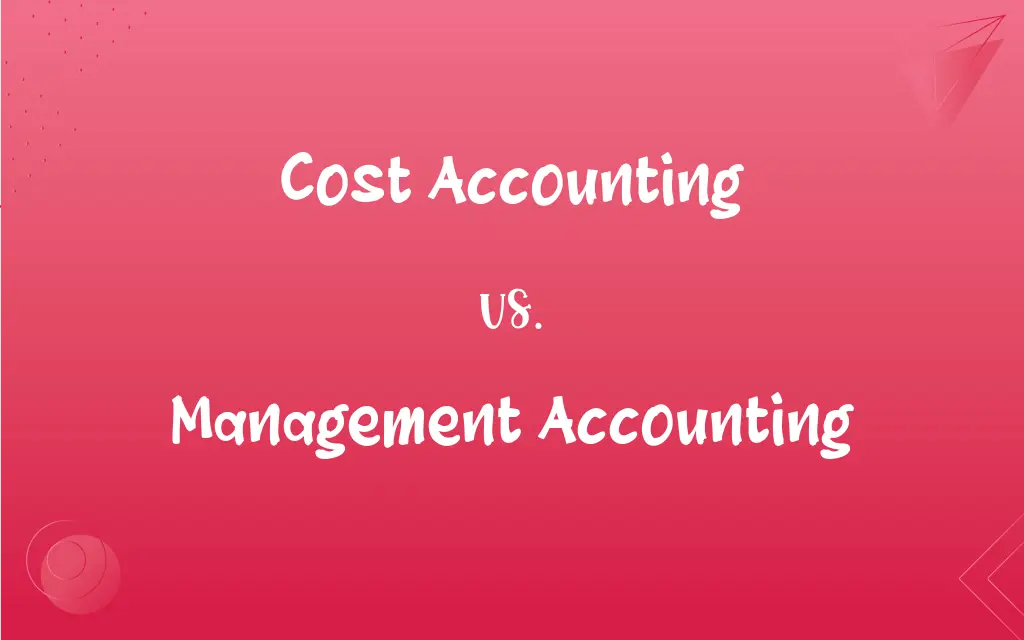Cost Accounting vs. Management Accounting: What's the Difference?
Edited by Janet White || By Harlon Moss || Updated on October 21, 2023
Cost accounting focuses on calculating the cost of production, while management accounting aids in decision-making using financial and non-financial data.

Key Differences
Cost accounting is the method of capturing and analyzing all costs incurred in a business operation. It primarily emphasizes evaluating production costs. In contrast, management accounting encompasses a broader scope, involving the use of both financial and non-financial data to guide management in decision-making.
While cost accounting primarily serves to determine product pricing or inventory valuation, management accounting helps managers make informed choices, plan, and control organizational operations, ensuring the company's goals align with its strategic objectives.
Cost accounting typically deals with historical data and often works within a short-term horizon, as it is essential to ensure profitability and measure performance against standards. Meanwhile, management accounting focuses on forecasting and takes a more forward-looking approach to assist managers in the long-term strategic planning of the business.
In cost accounting, accuracy is of utmost importance since the derived costs influence pricing decisions and financial statements. On the other hand, in management accounting, timeliness is more critical, and approximations are more acceptable if they aid in swift decision-making.
While cost accounting reports are generally for internal use and not shared with external entities, management accounting may produce reports for external stakeholders, like investors, to showcase the company's strategic direction and future potential.
ADVERTISEMENT
Comparison Chart
Primary Focus
Evaluating production costs
Guiding managerial decision-making
Data Type
Mainly financial
Both financial and non-financial
Time Orientation
Historical and short-term
Forward-looking and strategic
Importance of Accuracy vs. Timely
High accuracy is crucial
Timeliness is more critical
Reporting Audience
Primarily for internal use
Both internal management and potentially external stakeholders
ADVERTISEMENT
Cost Accounting and Management Accounting Definitions
Cost Accounting
A method to evaluate the cost of production or services.
Through cost accounting, the firm realized the production line's inefficiencies.
Management Accounting
Uses both financial and non-financial data to guide organizational strategies.
Management accounting provided insights beyond just monetary figures.
Cost Accounting
A system that aids in evaluating the profitability of different business segments.
The CEO used cost accounting to assess the profitability of each department.
Management Accounting
Aids in performance measurement, budgeting, and forecasting.
The CFO used management accounting to draft next year's budget.
Cost Accounting
Focuses on understanding the expenses associated with output.
Cost accounting highlighted areas where savings could be made in the manufacturing process.
Management Accounting
The practice of aiding management in decision-making using financial data.
Management accounting reports helped the team decide on the new expansion plan.
Cost Accounting
The process of recording and analyzing business costs.
The company used cost accounting to determine the price of its new product.
Management Accounting
Helps organizations align operations with their strategic goals.
Through management accounting, the company ensured its operations matched its long-term vision.
Cost Accounting
Provides data to help set product prices and control expenditures.
The manager relied on cost accounting to set a competitive price for their goods.
Management Accounting
Focuses on providing information for internal organizational planning.
With management accounting, the firm could strategically allocate its resources.
FAQs
What's the main objective of cost accounting?
The primary objective of cost accounting is to determine and control costs for pricing and profitability analysis.
How does management accounting benefit businesses?
Management accounting aids decision-making, planning, and controlling operations aligned with the company's strategic goals.
Can management accounting reports be shared externally?
Yes, management accounting can produce reports for external entities like investors to display strategic direction.
Is cost accounting used for external reporting?
Typically, cost accounting reports are primarily for internal use and not for external stakeholders.
Is cost accounting necessary for all businesses?
While it's beneficial for most businesses, its necessity varies depending on the industry, business model, and specific operational needs.
How is cost allocation used in cost accounting?
Cost allocation divides indirect costs among different cost objects (like products or services) based on direct measurements or estimates.
Which focuses more on historical data, cost accounting or management accounting?
Cost accounting usually emphasizes historical data, while management accounting is more forward-looking.
Do management accountants need to follow GAAP or IFRS?
No, management accounting isn't bound by GAAP or IFRS as it's primarily for internal use.
How do cost accounting and financial accounting differ?
While both deal with financial data, cost accounting focuses on determining production costs, whereas financial accounting provides a financial overview to external stakeholders.
How does cost accounting aid in pricing decisions?
Cost accounting provides a detailed breakdown of production costs, helping businesses set prices that ensure profitability.
Is management accounting useful for small businesses?
Absolutely, even small businesses benefit from the insights and strategic direction provided by management accounting.
What tools do management accountants typically use?
They use a variety of tools, including budgeting, forecasting, variance analysis, and scenario planning.
Which type of accounting is more focused on overhead costs?
Cost accounting delves deeply into overhead costs to allocate them appropriately to products or services.
Can cost accounting help in cost reduction?
Yes, by identifying inefficiencies or areas of waste, cost accounting can guide cost reduction initiatives.
Why is management accounting essential for strategic planning?
It provides a comprehensive view of financial and non-financial data, aiding in aligning operations with strategic objectives.
How does management accounting aid performance evaluation?
It provides metrics and analysis to assess the performance of various departments, projects, or strategies against set objectives.
Can both cost accounting and management accounting be used together?
Absolutely, they often complement each other, providing a comprehensive financial view to managers.
Can management accounting help with risk management?
Yes, management accounting can provide insights and analysis that help in risk assessment and mitigation strategies.
Do cost accountants need specific certifications?
While not mandatory, certifications like the CMA (Certified Management Accountant) can be beneficial for cost accountants.
Is management accounting more qualitative or quantitative?
While it heavily relies on quantitative data, management accounting also considers qualitative factors for a comprehensive analysis.
About Author
Written by
Harlon MossHarlon is a seasoned quality moderator and accomplished content writer for Difference Wiki. An alumnus of the prestigious University of California, he earned his degree in Computer Science. Leveraging his academic background, Harlon brings a meticulous and informed perspective to his work, ensuring content accuracy and excellence.
Edited by
Janet WhiteJanet White has been an esteemed writer and blogger for Difference Wiki. Holding a Master's degree in Science and Medical Journalism from the prestigious Boston University, she has consistently demonstrated her expertise and passion for her field. When she's not immersed in her work, Janet relishes her time exercising, delving into a good book, and cherishing moments with friends and family.
































































